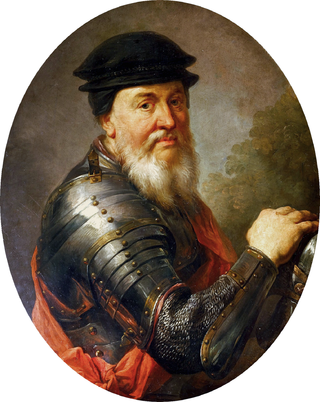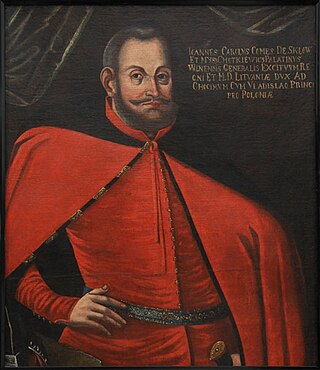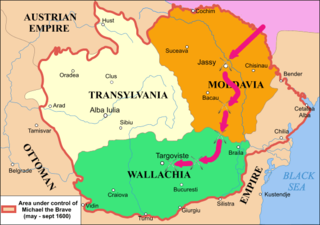
The Battle of Berestechko was fought between the Cossack Hetmanate and Crimean Khanate against the Polish–Lithuanian Commonwealth as a part of the Khmelnytsky Uprising. Near the site of the present-day city of Berestechko in Ukraine, a forces of the Zaporozhian Cossacks and Crimean Tatars under the command of Hetman Bohdan Khmelnytsky, Otaman Tymofiy Khmelnytsky, Colonels Ivan Bohun and Fylon Dzhalaliy with Khan İslâm III Giray and Tugay Bey, who was killed in the battle, was defeated by the Polish–Lithuanian Commonwealth's forces under the command of the Polish King John II Casimir, Prince Jeremi Wiśniowiecki, Hetmans Marcin Kalinowski and Stanisław Lanckoroński. The battle took place in the Volhynian Voivodeship on the hilly plain south of the Styr River. The Polish–Lithuanian camp was on the Styr River opposite Berestechko and faced south, towards the Zaporozhian Cossacks about two kilometers away, whose right flank was against the Pliashivka (Pliashova) River and the Crimean Tatars on their left flank. It is considered to have been among the largest European land battles of the 17th century.

Michael I was the ruler of the Polish–Lithuanian Commonwealth as King of Poland and Grand Duke of Lithuania from 29 September 1669 until his death in 1673.

Hetman is a political title from Central and Eastern Europe, historically assigned to military commanders. Used by the Czechs in Bohemia since the 15th century, it was the title of the second-highest military commander after the king in the Crown of the Kingdom of Poland and the Grand Duchy of Lithuania from the 16th to 18th centuries. Throughout much of the history of Romania and the Moldavia, hetmans were the second-highest army rank. In the modern Czech Republic, the title is used for regional governors.

Jan Karol Chodkiewicz was a military commander of the Grand Ducal Lithuanian Army, who was from 1601 Field Hetman of Lithuania, and from 1605 Grand Hetman of Lithuania. He was one of the most prominent noblemen and military commanders of the Polish–Lithuanian Commonwealth of his era. His coat of arms was Chodkiewicz, as was his family name.

The Battle of Cecora took place during the Polish–Ottoman War (1620–21) between the Polish–Lithuanian Commonwealth and Ottoman forces, fought from 17 September to 7 October 1620 in Moldavia, near the Prut River.

Petro Konashevych-Sahaidachny was a political and civic leader, who was a Hetman of Ukrainian Cossacks from 1616 to 1622. During his tenure, he transformed Zaporozhian Cossacks from irregular military troops into a regular army and improved relations between the Cossacks, the Orthodox clergy and peasants of Ukraine, which would later contribute to the establishment of a modern Ukrainian national consciousness. A military leader of the Polish–Lithuanian Commonwealth both on land and sea, Sahaidachny is best known for the significant role his troops played in the Battle of Khotyn against the Ottoman Empire in 1621, as well as the Polish Prince Władysław IV Vasa's attempt to usurp the Russian throne in 1618.
The Moldavian Magnate Wars, or Moldavian Ventures, refer to the period at the end of the 16th century and the beginning of the 17th century when the magnates of the Polish–Lithuanian Commonwealth intervened in the affairs of Moldavia, clashing with the Habsburgs and the Ottoman Empire for domination and influence over the principality.

Khotyn is a city in Dnistrovskyi Raion, Chernivtsi Oblast of western Ukraine, located south-west of Kamianets-Podilskyi. It hosts the administration of Khotyn urban hromada, one of the hromadas of Ukraine. According to the 2001 Ukrainian census, it has a population of 11,124. Current population: 8,936.

The Polish–Ottoman War of 1633–1634 was one of the many military conflicts between the Crown of the Kingdom of Poland together with the Grand Duchy of Lithuania and the Ottoman Empire and its vassals.

The Polish–Swedish War of 1621 to 1625 was a war in a long-running series of conflicts between the Polish–Lithuanian Commonwealth and the Swedish Empire. It began with a Swedish invasion of the Polish–Lithuanian fiefdom Livonia. Swedish forces succeeded in taking the city of Riga after a siege. The Commonwealth, focused on a war with the Ottoman Empire, was unable to send significant forces to stop Gustav Adolf, and signed a truce favorable to Sweden. The Commonwealth ceded Livonia north of the Dvina (Düna) river, and retained only nominal control over Riga. The new truce in Mitau was signed and lasted from November 1622 to March 1625.

The Battle of Khotyn or Battle of Chocim, also known as the Hotin War, took place on 11 November 1673 in Khotyn, where the forces of the Polish–Lithuanian Commonwealth under the Grand Hetman of the Polish Crown John Sobieski defeated Ottoman Empire forces, with Moldavian and Wallachian regiments, led by Husein Pasha. It reversed the fortunes of the previous year, when Commonwealth weakness led to the signing of the Treaty of Buchach, and allowed John Sobieski to win the upcoming royal election and become the King of Poland.

The Polish–Ottoman War (1620–1621) was a conflict between the Polish–Lithuanian Commonwealth and the Ottoman Empire over the control of Moldavia. It ended with the Commonwealth withdrawing its claims on Moldavia and led to the eventual demise of the Sultan Osman II.

The Polish–Ottoman War of 1672–1676 was fought by the Polish–Lithuanian Commonwealth and the Ottoman Empire. It ended with the Treaty of Żurawno, by which the Commonwealth ceded control of most of its territories in Central Ukraine to the Ottomans. It was a prelude to the Great Turkish War.
The Battle of Lyubar or battle of Lubar took place on 14–27 September 1660 near Lyubar, during the Russo-Polish War (1654–1667), between the forces of the Polish–Lithuanian Commonwealth and Tsardom of Russia. It was the first battle of the 1660 campaign in the south. It ended with a Polish victory. The Russian army retreated and was subsequently destroyed during the battle of Chudniv.

The Khotyn Fortress is a fortification complex located on the right bank of the Dniester River in Khotyn, Chernivtsi Oblast (province) of southwestern Ukraine. It lies within the historical region of northern Bukovina, a Romanian territory occupied in 1940 by the Soviet Union following the Molotov–Ribbentrop Pact. The fortress is located near another famous defensive structure, the Kamianets-Podilskyi Castle. Construction of the current stone Khotyn Fortress began in 1375. The fortress underwent significant improvements in the 1380s and in the 1460s under the Moldavian princes Alexander the Good and Stephen the Great.

Treaty of Khotyn (Chocim/Hotin), signed on 9 October 1621 in the aftermath of the Battle of Khotyn, ended the Polish–Ottoman War. With this peace treaty, the Khotyn fortress was gived to Moldavia as a Ottoman vassal and the Polish–Lithuanian Commonwealth agreed to stop its interference in Moldavia. Both sides claimed victory, as the Commonwealth saw the battle of Khotyn as successfully stopping the Ottoman Empire's invasion of its mainland.

The Battle of Podhajce was fought in the town of Podhajce in the Polish–Lithuanian Commonwealth, and the area surrounding it as part of the Polish-Tartar War and the Great Turkish War. The army of the Polish–Lithuanian Commonwealth under John III Sobieski, totaling around 9,000 men, defeated Tatar and Cossack forces under Petro Doroshenko and Adil Giray, which totaled around 35,000 men.
The Battle of Komarno took place on October 9, 1672, during the Polish-Ottoman War (1672-1676). It was part of Jan III Sobieski’s autumn expedition, aimed at destruction of mounted Tatar units, which plundered southeastern provinces of the Polish–Lithuanian Commonwealth.
Canibek or Janibek Giray was twice khan of the Crimean Khanate. During his first reign he fought for the Turks in Persia and Poland. He proved a poor commander and had difficulty making his men obey. He was removed by the Turks in 1623. In the following year the Turks tried to restore him and failed. During his second reign there were raids on Poland and Russia. The Turks again removed him and he died in exile.

The Moldavian campaign of Tymofiy Khmelnytsky in 1653 was a military campaign in Moldavia and Wallachia by the Cossack-Moldavian army of the voivode Vasile Lupu and the hetman in charge, Tymofiy Khmelnytsky, against the pretender to the Moldavian throne, George Stefan, and the Wallachian troops of prince Matviy Basarab, supported by mercenaries from Transylvania, Poland, and Serbia. The Cossack-Moldavian army was defeated, and Tymofiy himself was killed, which put an end to Bohdan Khmelnytsky's attempts to include Moldavia in the sphere of influence of the Zaporozhian Army, as well as to Lupu's attempt to take the throne of Wallachia and his power in Moldavia.




















